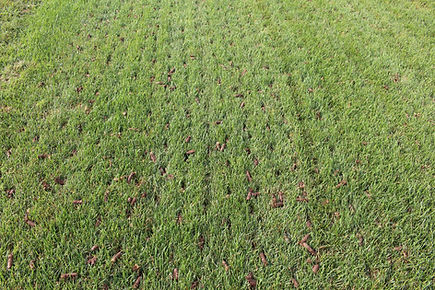NJ Tree and Lawn Care Services by Plant Solutions:

Lawn Aeration Services in NJ
Aeration is the removal of small cores of soil to allow air, moisture and fertilizer down to the root zone. A core aerator will pull one to two inch plugs of soil from the ground. These plugs are deposited on the soil’s surface where they will break down. Soil surrounding the plugged holes and the soil deposited on top will collapse and fill in. It doesn’t work to use aeration equipment that simply punches a hole in the soil. While a hole may be created, the “punched” soil merely compacts the soil surrounding the hole.

Why does my lawn need core aeration?

Helps your lawn breathe easy
Compacted New Jersey clay/loam soils impede the movement of air, water and nutrients to the grass roots. When compacted, soil contributes to the accumulation of thatch because restricted oxygen levels impair the activity of earthworms and other thatch-decomposing organisms.
Roots require oxygen to grow and to absorb nutrients and water. When compacted, soil contributes to the accumulation of thatch because restricted oxygen levels impair the activity of earthworms and other thatch-decomposing organisms.

Reduces thatch and moss
Thatch accumulates faster on compacted soils and heavy clay soils than on well aerified soils. When thatch thickness depth exceeds 3/4” it becomes a problem, reducing water movement and encouraging shallow, weak root systems. Thick thatch also can become a home for insects and disease.
Moss is quite common, especially in New Jersey. Lawn areas that drain poorly due to soil compaction are displaying a “Moss Welcome” indicator. Aeration breaks up the surfaces of your lawn allowing rain to drain through properly.
How core aeration works
The controlled removal of the small soil cores has many benefits. It allows fertilizer, water and air to quickly reach the root zone of your grass. Both drought and heavy rain stress your grass. During drought conditions, aeration helps water reach thirsty roots. When rain is heavy, it allows air to penetrate and help dry up excess moisture. Core aeration creates healthy roots and thicker, more beautiful lawns.
-
Core aeration involves the removal of small soil plugs or cores out of the lawn. Known as a core aerator, the machine extracts 1/2 to 3/4 inch diameter cores of soil and deposits them on your lawn. Aeration holes are typically 1-3 inches deep and 2-6 inches apart.
-
Core aeration is a recommended yearly lawn care practice to control thatch buildup, especially on compacted, heavily used turf.

When is the best time to aerate my lawn?
It’s never too soon (or too late) to start improving the health and appearance of your lawn. At Plant Solutions Lawn Care, we will professionally core aerate your lawn using the most advanced equipment and best-qualified personnel.
-
The best time to aerate your cool-season lawn (Blue Grass) is late summer early fall.
-
The best time to aerate your Tall Fescue lawn is in the fall, in conjunction with fall reseeding.










